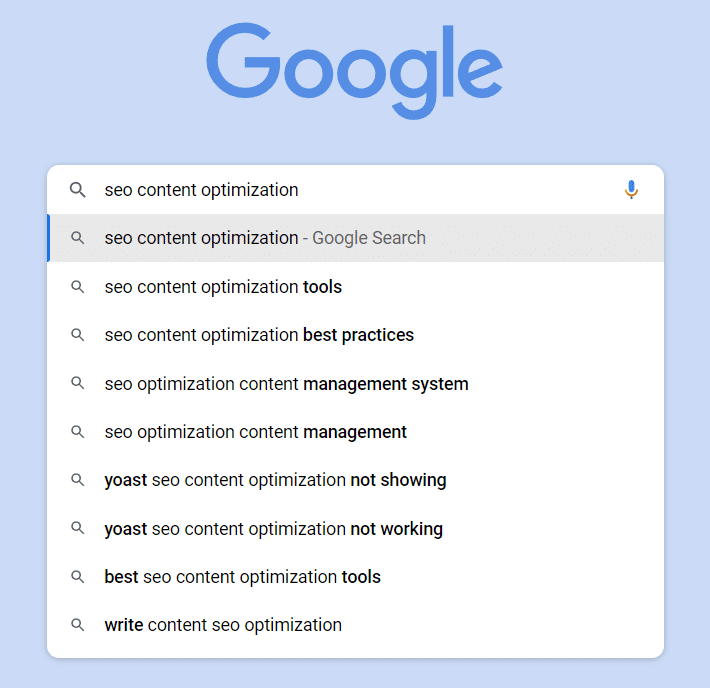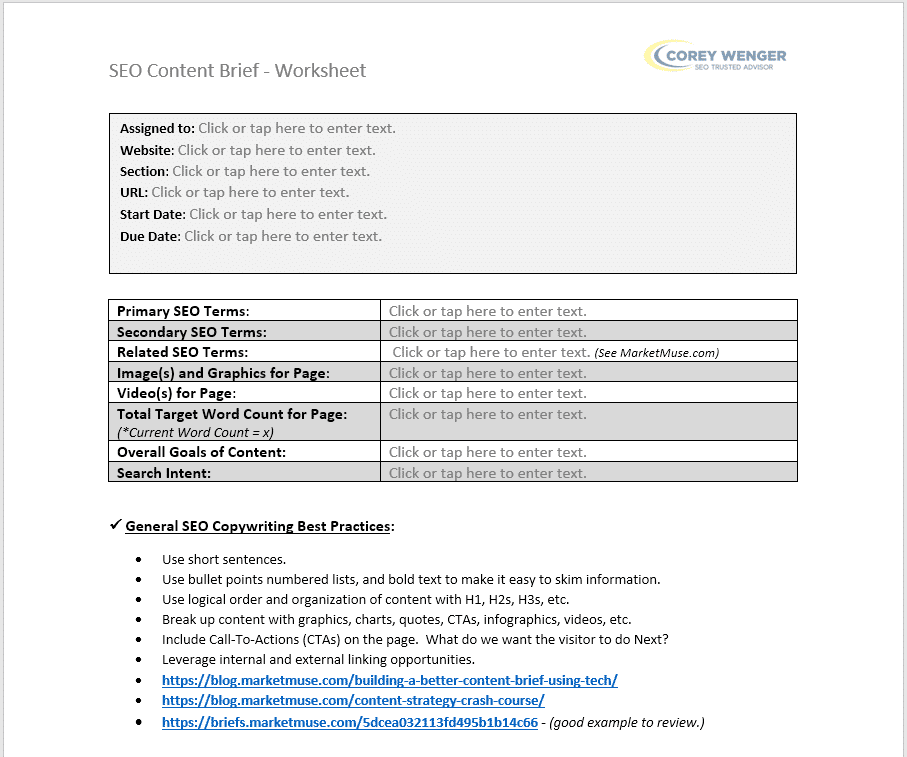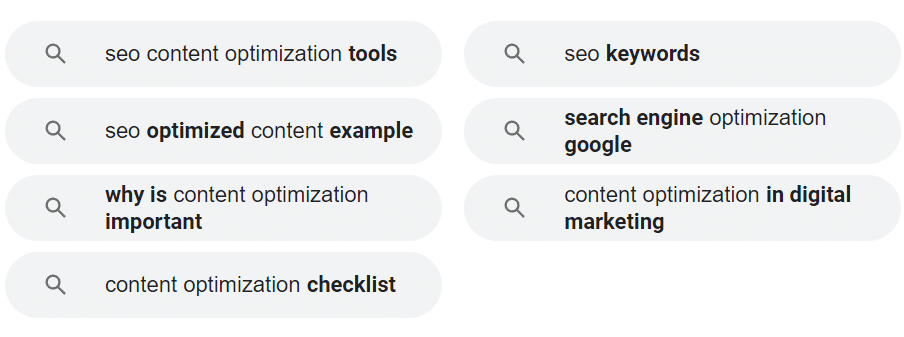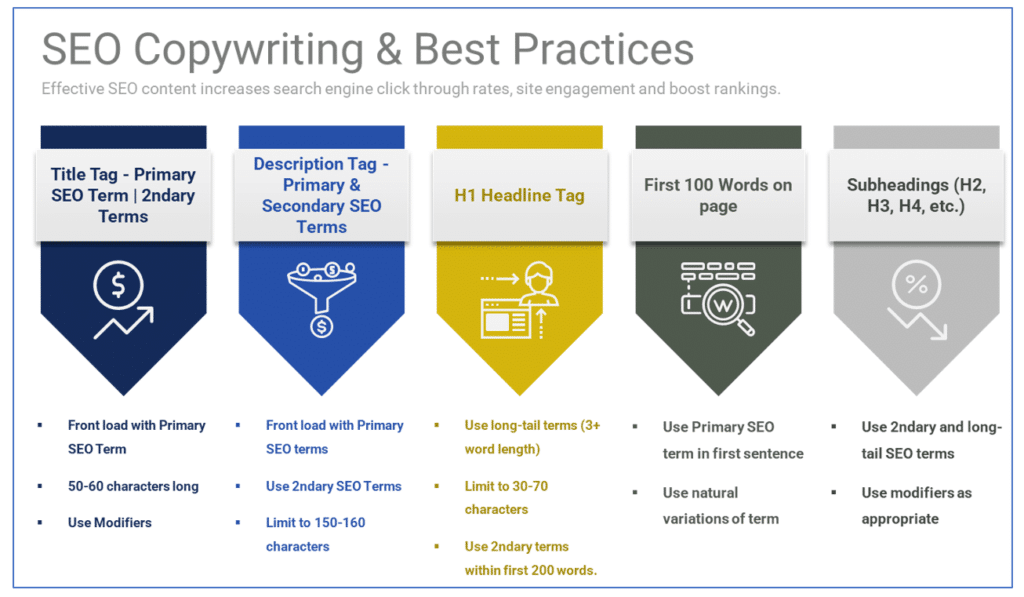
Quick Links
The Definitive Guide to Optimizing Your SEO Content (in 2023)
The success of your SEO program is only as good as the content, keywords, and topics you pick to optimize for. The following article will provide the process for finding and qualifying the best SEO terms to target for existing web pages, blogs, and other content. Let’s dive in.
1) Pick High-Value Content for SEO Optimization.
✔️ Web content can be broken into three tiers.
✔️ Tier 1 content:
-Highly relevant and valuable content for the target audience has high monthly search impressions and tends to be evergreen content (does not have a temporary shelf life before it becomes outdated or irrelevant.)
-This content also matches the company’s business and marketing objectives and generally ranks in positions 7-15 in Google.
-Data – look at Google Search Console’s top web pages over the last 12 months by total impressions.
-Data – review Google Analytics Organic Traffic – Landing Page data – page views, traffic, engagement metrics like average time on page, bounce rates, etc.
✔️ Tier 2 content:
-Medium level of monthly impressions, secondary importance to Tier 1 content, generally is evergreen and ranks in positions 7-15 in Google.
✔️ Tier 3 content:
-Lower monthly impressions, lower–value content value when compared to Tier 1 and 2 content and typically ranks in positions 30+ in Google.
2) Choose Your Primary SEO Terms and Main Topics.
✔️ Every web page content will typically target 1-2 primary SEO terms for that piece of content.
These are the most important topics and search terms you want to optimize for.
Here is the general process to follow when identifying Primary SEO Terms.
Conduct a Google search for these terms.
Examine the top 10 listings to determine if the search results trigger the types of content you would expect to see.
Is there a match between your Primary terms and the search results pages?
Is there a mismatch between your Primary terms and the search results pages (SERPs)?
What is the search intent for the Primary terms?
Search Intent is the main goal or objective a user has when typing a query into a search engine. There are four types of Search Intent.
✔️ Informational:
The searcher is looking for information. This might be an answer to a simple question like “who is the president of the United States?”.
✔️ Commercial:
The searcher is in the market for a specific product or service but has yet to make a final decision on which solution is right for them. They’re most likely looking for reviews and comparisons
✔️ Transactional:
The searcher is looking to make a purchase. They’re in buying mode. Most likely, they already know what they want to buy. They’re looking for a place to buy it from.
✔️ Navigational:
The searcher is looking for a specific website. They already know where they want to go. It’s probably quicker and easier for them to Google it.
3) Choose Your Secondary SEO Terms and Subtopics.
✔️ Each page will typically target 2-3 secondary SEO terms for that specific piece of content.
These terms are generally close to the Primary SEO terms and are three-plus words.
A simple process to find secondary terms (based on your primary terms) is to Google the terms and use some standard SEO tools.
✔️ Google Auto Suggest Feature.
Let’s begin by doing a Google search with our Primary SEO Term.

When you enter the search in the Google search box, Google will automatically suggest possible search results.
In the case below, we are searching for “seo content optimization.”
To find relevant secondary terms, look at the suggestions and see which likely close variants you would want to use in your content.

In addition, review other Google search results. These include “People Also Ask” and “Related Searches.” These questions and searches provide good candidates for secondary SEO Terms.

To find and research Primary and Secondary SEO Terms and Topics, you can also use various Keyword Research tools. These include Google Search Console, Google Ads Keyword Planner, Moz, SEMRush, KWFinder, and many other tools.
4) Find Related SEO Terms and Topics.
✔️ It is also important to identify related terms and topics you would expect to see with your Primary and Secondary SEO Terms.
Ask yourself, “What related content is used around your Primary and Secondary keywords?”
The best tool to use semantically related keywords and content is MarketMuse.com.
✔️ MarketMuse.com is a monthly subscription SEO Keyword and Content Optimization tool. Monthly investments for this tool range from $600 per month.
Pricing info – https://www.marketmuse.com/pricing/.
This is one of my favorite content tools to write specific content that incorporates your primary, secondary and related keywords.
This tool analyzes 1,000s of Google search result pages and builds a content profile to match your primary SEO term.

The content is scored from 0 to 100, and target ranges are suggested. For example, the current score is 56, the average Google SERP is 35, and the minimum recommended score is 52. It also suggests a total word count of at least 1,603 words.
In the righthand column, you will see keywords with the number of times the keyword is used in the existing content and the suggested number of times you should use the keyword within the content.
This analysis tells you which keywords you are overusing within your content and which terms you are not using enough.
Terms in red or yellow mean the terms are missing or not used often enough throughout your content. Terms in green or blue represent important terms you are using within the correct range.
As you update your content (in real-time), the SEO score and word count will automatically be updated. Once you have revised the content to improve the SEO score, save the writing and export the copy to update your existing web pages and blogs.
5) Always Use Your SEO Content Brief / Worksheet.
✔️ Once you have done your keyword research to identify your primary, secondary, and related keywords, I suggest compiling your parameters into a content brief or worksheet.
This helps standardize the workflow around optimizing existing and new content.

6) SEO Keyword and Topic Research Tools.
✔️ Google Search Console
This is a free tool provided by Google.
*Please note you will need a Google Account to use this tool. In many instances, the account and login credentials you use for your Google Analytics will also work here.
First, log in to your Analytics or Google Account. Then log in via this link – https://search.google.com/search-console/welcome.
Once you log in, navigate your website using the drop-down arrow for Search Property.
From the main account view, choose Search Results under the Performance Section (on the left side navigation menu.) Next, click the checkboxes for Average CTR and Average Position.
Then expand the Date range to the last 12 months. Click on the pencil icon to change the setting. Select Last 12 Months and click apply.
To analyze the search volumes, keyword rankings, total clicks, and total impressions, click “+ New.”
Select Page and copy and paste the URL you want to analyze with the URL box, then click apply.
Once you click apply, you will see the following data for the specific URL you entered. It will provide historical, page-specific information for the last 12 months on top queries, impressions, clicks, and click-through rates. (Click the Impressions to sort by highest to lowest impressions.)
When choosing your Primary and Secondary SEO Terms, look for highly relevant terms, have high impressions, and rank (position) within 7-15.
You can choose terms that rank 15+, but these require much more content and links to rank well for.
Once you have selected good SEO term candidates, conduct a live Google search to identify relevancy and fit between your content and Google Search Result Pages (SERPs). Also, remember the user’s search intent (Navigational, Informational, Transactional, or Commercial).
When analyzing terms, look for topical themes within the term list.
What is the primary theme for your content?
What additional information would a customer be looking for (besides the Primary SEO term information)?
Think of not just terms but topics of information.
✔️ SEMRush Keyword Magic Tool
This paid subscription tool is excellent for keyword research and grading existing content. The monthly subscription ranges from $119.95 to $229.95 per month. Pricing info – https://www.semrush.com/prices/.
Navigate to the Keyword Magic tool on the left-hand side menu.
Enter your base term and analyze the results.
SEMRush provides a ton of excellent data around your terms. It includes search intent, monthly search volumes, trends, Keyword Difficulty Score, average CPC, number of competing pages.
This tool can save you time determining the searcher’s intent, as well as looking at trending data and search term modifiers. A modifier is an associated topic that is relevant to your base term. It shows you what closely related terms and topics customers are searching for.
The tool also makes it easy to filter your search term list by Keyword Difficulty, search volumes, keyword including or excluding, and other filters.
The tool also provides a simple way to build out keyword lists by adding them to the Keyword Manager.
7) Grade Your Existing Content For SEO Rankings and Topical Relevancy.
✔️ MarketMuse.com is an excellent tool to grade and identify keywords and content you need to implement to improve your ranking ability.
MarketMuse.com requires a monthly subscription of $600+ per month.
This is one of my favorite content tools to write thorough content incorporating your primary, secondary and related keywords.
This tool analyzes 1,000’s of Google search result pages and builds a content profile to match your primary SEO term.

Terms in red or yellow mean the terms are missing or not used often enough throughout your content. Terms in green or blue represent important terms you are using within the correct range.
As you update your content (in real-time), the SEO score and word count will automatically be updated. Once you have revised the content to improve the SEO score, simply save the writing and export the copy to update your existing web pages and blogs.
8) General On-Page SEO Copywriting Best Practices.
✔️ The following are quick tips when it comes to SEO Copywriting.
9) Title Tags.
✔️ A title tag is an HTML element that specifies the title of a web page. Title tags are displayed on search engine results pages (SERPs) as the clickable headline for a given result and are essential for usability, SEO, and social sharing.

Best Practices:
• The general recommendation is to keep the title length between 60-70 characters with each word separated by a space, plus make it useful, relevant, and representative of the page and Primary and Secondary SEO Terms.
• Front-load your Title Tag with your primary and secondary search terms for the web page. (Ex. Primary Phrase | Secondary Phrase | Brand)
• Every page should have a unique Title Tag.
• Use Call-To-Action words in your tag (Get, Take, Learn, Buy, Find, etc.)
• Remove messy dynamic parameters when possible. Instead, utilize mod_rewrite or ISAPI rewrite or MS’ URL Rewrite Module to rewrite search engine and web visitor-friendly URLs. (Static, clear URLs can improve Click-Through-Rates.)
• Generally, your Title Tag and Header Tag (H1) should NOT be identical.
Source: https://moz.com/learn/seo/title-tag
Source: https://www.semrush.com/blog/on-page-seo-basics-page-titles/
10) Meta Description Tag.
✔️ Meta Descriptions have no impact on SEO. However, they do impact CTR from search results, so it is good to optimize for them in general.

Best Practices:
• Keep total characters between 140-150 (up to 920 pixels wide) for desktop and no more than 120 characters for mobile.
• Utilize your targeted primary phrase and secondary phrase in the description.
• Every page should have a unique Meta Description.
• Describe benefit, Unique Value Proposition, and make it highly relevant to your audience.
• Utilize action words and a clear call to action.
Source: https://moz.com/learn/seo/meta-description
Source: https://help.ahrefs.com/en/articles/2630975-meta-description-tag-missing-or-empty-error-in-site-audit
11) H1 Headline Tag.
✔️ Search engines use the H1 tag to interpret what a page is about, much like readers of a magazine use article titles to get an idea of what an article is about.
When pages are missing H1 tags, it’s harder for visitors and search engines to decipher what the page is about. Therefore, the H1 tag should contain the Primary SEO term you are targeting for the page.
Best Practices:
• Use H1 Tag for each page on your site.
• H1 and Title Tag can be the same or very similar.
• Use Title case for H1s and use only one H1 per page.
• Use your primary SEO term in the H1 tag.
Source: https://www.contentkingapp.com/academy/headings/
Source: https://ahrefs.com/blog/h1-tag/
12) First 100 Words On The Page.
✔️ To help Google and other search engine determine the topic of your web page, use your primary SEO term within the first 100 words of the page.
Best Practices:
• Front-load page with primary SEO terms.
• Use natural variations of primary terms within the first 100 words of the page.
13) Breakup Content With Subheadings (H2, H3, H4, etc.)
✔️ To best incorporate your secondary SEO Terms, use them within the sections of your web page, including your subheadings.
Best Practices:
• Use secondary terms and long-tail terms in your page’s subheadings (H2 and H3).
• Use search term modifiers where appropriate.
• Front-load your H2s and H3s with your SEO terms.
• Use headings naturally to break up big chunks of content.
14) Use Internal Linking To Boost Rankings.
✔️ Using keyword-rich internal links can help improve SEO rankings.
Identify blogs and other pages containing search terms and topics you want to link to.

For example, if you want to help build internal links to strengthen the SEO value of a web page, first determine which page you want to improve SEO rankings. Then identify content within your site that you can link from.
A simple way to identify search term content with your domain is to use the following Google search operation – in the search box, place “site:yourwebsite.com term.”
This will identify web pages that contain the content “your term.”
Review these pages and identify a list of linking pages to your target page.
Final Thoughts
This article discusses the SEO Content Optimization process and tools (like Google Search Console, SEMRush, and MarketMuse) that are used to help identify primary, secondary, and related terms and topics. In addition, MarketMuse is an excellent tool to help grade, score, and optimize your content for topical relevancy and coverage.
Learn more about Corey Wenger National SEO Consulting Services, Local SEO Consulting Services, SEO Consultant Services, Technical SEO Audits or SEO Audit Services.
About the Author
Corey has over 20 years of Digital Marketing and SEO experience and is the owner of Corey Wenger SEO Consulting. Corey is an SEO Expert and Consultant and has deep knowledge in troubleshooting, educating, coaching, guiding, and scaling your SEO Strategies and tactics so that you can increase keyword rankings, leads, and sales. Additionally, Corey helps businesses develop SEO Strategies to compete more effectively against search engine competition. Corey is also an SEO Trainer and enjoys helping his clients learn and master SEO tactics, tools, and strategies.
Ready to get your SEO Audit started?



